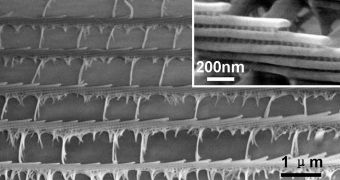Want sex? Put on the showiest clothing, drive the shiniest car, display the catchiest tattoos and maybe you'll get some. Or at least you have tried. But that's, in fact, an ancestral animal trait; that we still have to do it. Just look at the bright colors in feathers, scales, faces, or insect wings.
But in the case of the butterflies, a team of ASU biologists showed that things go further than what we see: male butterflies employ sophisticated nanotechnology and ultraviolet wavelengths to get a girl. "What we see as color is really a manipulation of light. The structures used are so small, and our understanding of the way that light interacts with these surfaces at that scale is really rudimentary." said co-author Nathan Morehouse, a graduate student of Ron Rutowski's, professor in the School of Life Sciences.
Most animal colors are pigment-based: the material absorbs some colors of the reflected light. But light can be manipulated through physical structures that reflect some light wavelengths while letting others pass through, like on oil slicks. Butterflies have been found to do both at once. Their wings present on the surface a combination of long ridges that overlay a trellis studded with beads.
The trellis and ridges had been known to scatter light due to their structure, but the new research made on the Checkered White revealed that the beads present pterin pigments, and that the football shape and the disposition of the beads within the trellis come with a second structural component to the color pattern, turned brighter and more chromatic.
"Photonics is a hot area in optical physics, which can benefit from understanding of such structures, for example for development of optical data transfer. In terms of nanofabrication, nature has surpassed mankind for now, in structural intricacy and manufacture, producing nanostructures at body temperature and neutral pH, without caustic reagents or environmental damage and with enviable repeatability for millions of years," said Morehouse.
What stands for such complex structures? You got it: sexual selection. "Female butterflies have many fewer pterin 'footballs' than males," said Morehouse. Females were found to be attracted by the males with the highest quality color and the brightest flash of ultraviolet light (UV).
One yellow butterfly species, Colias eurytheme, can strobe an iridescent UV color pattern on males at almost 20 times a second. The variability in color and iridescence of the males points to the female butterflies the fitness of each male. "These traits are heritable. Offspring from the flashiest males are flashier." explained Rutowski.
Pterin pigments found how well butterflies cope with the nitrogen scarcity on their alimentation. The vegetarian caterpillars eat a food rich in sugars, but very poor in nitrogen-containing proteins. The way larvae cope with nitrogen lack translates into more or less color and flash.
"Pterin pigments are the most nitrogen-rich pigments described in the animal kingdom. So the mystery is that while caterpillars eat food that isn't very high in nitrogen, butterfly wings in these dimorphic species are packed with pterins." said Morehouse.
"How butterflies see each other is enriching our understanding of butterfly coloration, how and why it is being produced, and what is it doing - in the context of our broader understanding about the function of evolution and production of coloration of animals".

 14 DAY TRIAL //
14 DAY TRIAL //